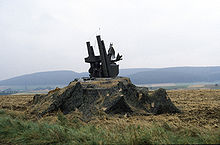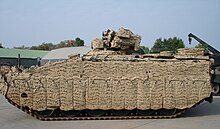Camouflage net


Camouflage nets serve in the military the visual protection from enemy reconnaissance . They imitate vegetation . For example, they are hung or laid above positions , bunkers , buildings, radar positions , tanks , self-propelled howitzers and anti-aircraft guns and, if necessary - depending on the regional vegetation - supplemented with woven branches, bushes, grass and scraps of cloth to improve the camouflage effect. Some versions are waterproof and rot-proof thanks to impregnation and are also fire-retardant. They can also serve as wind and sun protection.
history
First World War
The military use and production of camouflage nets was accelerated at the end of the First World War , after the camouflaging of positions and staging areas against the now active aerial reconnaissance had become necessary. The contour-dissolving camouflage paint alone was no longer sufficient, there was a need for artificial camouflage means, as the branches used for camouflage withered quickly and there was no foliage in the winter months.
The heavy equipment used by artillery and combat troops now had to be protected against aerial reconnaissance using artificial camouflage. First one made do with tarpaulins with camouflage print and sack linen that no further treatment has been applied. The French army set standards here and employed a painter who knew how to imitate nature, light, shadows and metal by painting these fabrics in such a way that the camouflaged guns and limbs were difficult to spot even for the most trained eye. This French painter achieved the rank of captain . This camouflage work resulted in the construction of dummy trees as observation posts, or the perfect camouflage painting of bunkers. Equipping nets with such painted scraps of fabric was more of an emergency solution, as it was not possible to equip all associations with the painted tarpaulin. An attempt was made to achieve a greater supply density by equipping networks. It was found that soldiers supplemented the nets with natural camouflage material and so the ideal basic camouflage equipment should be a basically equipped net, which could be adapted to the environment by the troops through on-site measures.
Between the world wars
In the interwar period , the defensive planning of national defense and the construction of fortifications along national borders made the need for appropriate camouflage nets so great that the nets were now manufactured industrially. The nets were garnished with burlap-like strips of fabric, which were soaked in so-called indanthron dyes , in order to dye them in camouflage color (dark green) and thereby protect the material from weathering and rotting. The garnish was woven through the net in a spiral shape and in zigzag lines and fixed by knotting. This type of nets can often be seen on old pictures of the Atlantic Wall positions or the Siegfried Line - here it can also be seen that the camouflage effect was probably just sufficient to cover up outlines and thus make it difficult to detect them precisely, but the nets were rarely of the same type Troop on site were supplemented by further camouflage measures. These camouflage nets, at least on the German side, were made of single-colored components.
Second World War
In the further course of the war, camouflage measures were given a lot of attention out of sheer necessity. Manuals and regulations have now been written and illustrated in order to familiarize the troops with measures that were absolutely necessary due to the air superiority of the enemy.
Another turning point was the consistent use of color film material for clarification, so that the colors could now also be clearly used for recognition to contrast the images.
Photographs and recordings from the staging rooms in Normandy show that all vehicles, handcarts and steel helmets were painted in camouflage colors in order to be as invisible as possible to the enemy fighter-bombers . Tanks were hidden in the woods with flat net camouflages and could only be used during the day under heavy anti-aircraft protection.
The allied associations used camouflage nets, which were also garnished with strips of fabric. However, these were much larger and individual scraps of fabric were as big as cleaning rags, so that the long-distance effect and density of these networks was more effective.
Warships that were lying in harbors for repairs or had to carry out “field repairs” and were thus an easy target for enemy warplanes and ships, were covered with camouflage nets in order to hide them. Such as the damaged heavy cruiser USS New Orleans after the Battle of Tassafaronga near Tulagi in 1942.
After the Second World War
At theaters of war such as B. North Africa, nets were used that were used without any garnish and were made from very thick strands. The nets were partially supplemented with natural-colored sackcloth strips.
Basically, the introduction of camouflage nets was also important for the troops from a psychological point of view, the shielding against enemy vision conveyed a certain security and the feeling of "having a roof over your head". The actual effect and the success of the camouflage measures, however, originally depended on the troop unit that used it, which also carefully carried out the extended camouflage measures and B. had to cover up vehicle tracks that led under the nets.
present
Even today, the camouflage net has become an integral part of military use. Despite thermal imaging devices and infrared (modern camouflage nets meanwhile also provide limited protection against these reconnaissance devices), they are still in use. Depending on the country, field research was carried out, so the appropriate camouflage net was developed for every terrain, whether desert or grassland, forest or ice desert .
The latest development are so-called lightweight systems, which consist of an ultra-light garnish and do not have an actual net. These "nets" can be compressed to the smallest pack size and are used to camouflage individual soldiers or small devices from special units.
The ghillie suit , a camouflage suit in which the camouflage net garnish is sewn directly onto the clothing in order to increase the personal camouflage of individual soldiers such as snipers , is increasingly used again today. Helmet nets such as the Mitznefet are used for contour resolution and camouflage . Some NATO countries use camouflage nets in forest or desert camouflage for armored vehicles.
Camouflage is still the art of adapting the object to be camouflaged to its surroundings and confusing the observer's eye. The camouflage should make it much more difficult for an opponent to recognize the target. In addition, the terrain and the choice of your own position play an important role for camouflage options - striking terrain points are therefore to be consistently avoided.
In the Bundeswehr soldiers are given official helmet camouflage covers made of fabric, on which there are fastening options in the form of loops for plant material (branches, bushes, grass). Improvised, tailored pieces of camouflage net or sackcloth strips can also serve as a helmet camouflage. Plant material used as helmet camouflage wilts over time and has to be constantly renewed, but the improvised camouflage net cover is durable.
During foreign missions of the Bundeswehr in endangered field camps, the inside of the windows of the buildings are partially reinforced with sandbags and provided with cut-out pieces of camouflage net that act like curtains. This is intended to serve as a privacy screen to protect against snipers and snipers who can then no longer target soldiers through the window.
Hunters use camouflage nets and ghillie suits to camouflage their high seats from game and to stalk game.
See also
literature
- F. Heil: Curtains, various camouflage nets , in Jaeger, February 2009 edition, pages 70–73. ( online PDF 1.2 MB )




